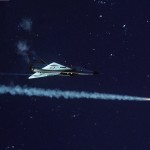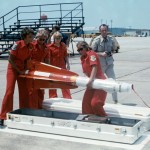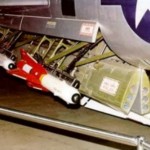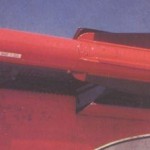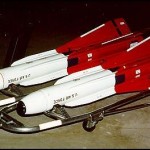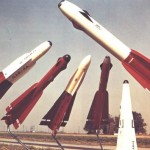
The first working guided air-to-air missile in the American inventory, the Hughes AIM-4 “Falcon” was the product of 10 years of development that started a year after the end of WWII. By 1949, Hughes had a testable prototype missile, but it wasn’t until 1956 that the “Falcon” would enter service.
The AIM-4 is an example of compartmentalization in the Department of Defense. In 1946, while the Navy was developing a missile in-house at the Naval Ordnance Test Station at Inyokern, California, (now Naval Air Weapons Station China Lake) that would eventually become the AIM-9 “Sidewinder,” the Air Force gave a contract to Hughes Aircraft to develop its own air-to-air homing missile. That led to problems.
The AIM-4 went through several designated names as development and naming conventions progressed — MX-798, MX-904, F-98, AAM-A-2, GAR-1, and GAR-2. During the time period in which the missile entered service, the biggest fear came from massive, nuclear-armed Soviet bombers. The “Falcon” was fit to the Air Force’s fast interceptor jets, like the F-89, F-101B, and F-102. Canada, Finland, Sweden, and Switzerland also purchased AIM-4s for use in the CF-101, Saab 35 Draken, and Mirage III. The missile was intended to stop these bombers from wiping out the west.
The GAR-1 variant found its target through semi-active radar homing (SARH) with a range of about 5 miles. The GAR-2 missile (later AIM-4B) was heat seeking. Other versions, including the larger AIM-4E/F/G “Super Falcon” would also come. More than 42,000 missiles were built, but they only ever achieved five kills in combat.
The problem with the AIM-4 was that it was built to fight an enemy that would never materialize. The United States has not had to engage large bombers since World War II. The “Falcon” was not designed to hone in on a fast-moving, maneuverable fighter jet, which has been the only air-to-air enemy engaged en masse by American forces since the 1940s. The missile also lacked a proximity fuse, meaning it had to score a direct hit on an enemy in order to explode. During the Vietnam war, the missile was essentially useless against MiG-17s and 21s.
The USAF F-4 “Phantom II” was designed to shoot the AIM-4, which made the gun-less F-4 ineffective at the beginning of the war. The F-4 was quickly modified to carry the Navy’s AIM-9 “Sidewinder.” The AIM-9 remains in service to this day.
As was par for the course in the 1950s, Hughes also built a larger “Falcon” that carried a 0.25-kiloton nuclear warhead, called the GAR-11 (later AIM-26) and a longer range version called GAR-9 (AIM-47).
Specifications
Length: 78 in (GAR-1) 79.5 in (GAR-2)
Wingspan: 20 in
Diameter: 6.4 in
Weight: 119 lb (GAR-1) / 135 lb (GAR-2)
Speed: Mach 3
Range: 6 mi
Guidance: semi-active radar homing (GAR-1) / rear-aspect infrared (GAR-2)
Warhead: 7.6 lb high explosive
Essential Reading
Online Resources:
